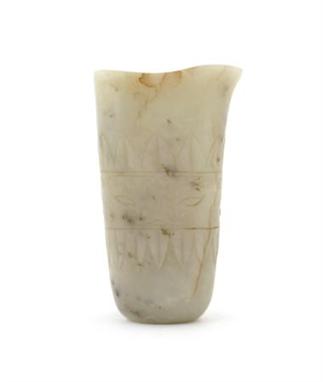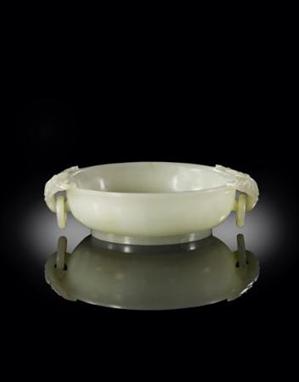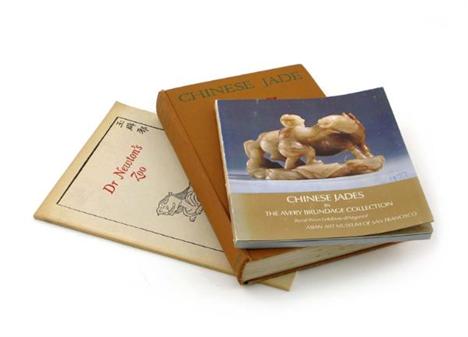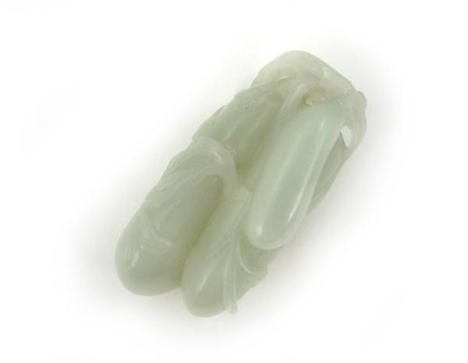We found 34370 price guide item(s) matching your search
There are 34370 lots that match your search criteria. Subscribe now to get instant access to the full price guide service.
Click here to subscribe- List
- Grid
-
34370 item(s)/page
A small Chinese jade carving of a rolling horse, probably 17th century. Stretching its head around to gnaw at its rear hoof and its tail curled beneath it, the creamy coloured stone flecked with brown striations, 7cm. Provenance: from the deceased estate of a New York collector. Cf. Watt, Chinese Jades from Han to Ch’ing, no.64, p.8, where he illustrates a Tang dynasty jade depicting the same theme and notes that the coiled position ‘is similar to stone or pottery lions of the Tang period with one of the hind paws at the mouth or scratching one ear’. The horse ‘Ma’, is a symbol of speed and of peace, because in ancient China they were used to bring peaceful tidings.
A small Chinese pale celadon jade carving of a cat and her kitten, 18th/19th century. The stone flecked with dark markings, together with a wood stand, 4.5cm. (2) Provenance: from the deceased estate of a New York collector. The Chinese name for ‘cat’, Mao, is homophonous with the word for ‘age eighty to ninety’. The cat is thus a symbol of longevity.
A fine Chinese pale celadon jade small vase and cover, 18th/19th century. Crisply carved with Liu Hai, the God of wealth, holding a coin and a gourd from which cloud scrolls emanate, the other side with his three-legged toad, together with a wood stand, 9.2cm. (3) Provenance: from the deceased estate of a New York collector.
A small Chinese white jade carving of a recumbent cat, 19th/20th century. With a hardwood stand, 4cm. (2) Provenance: from the deceased estate of a New York collector. The Chinese name for ‘cat’, Mao, is homophonous with the word for ‘age eighty to ninety’. The cat is thus a symbol of longevity.
A fine Chinese white jade circular plaque or dish, 18th/19th century. The slightly convex side carved in shallow relief with a figure on a raft encircled by waves and ruyi-shaped clouds and with a small toad, the reverse dished and with waves and clouds around the border, together with a hardwood stand, 7.6cm. (2) Provenance: formerly in the collection of Sidney Lines, of Wiggins Teape, Hong Kong.
A rare Chinese pale celadon jade perfume holder, Qianlong 1736-95. The reticulated cylindrical body with green jade fittings to each end, the body deeply carved with two small figures walking in a mountainous rocky landscape, with a further figure beneath a pine tree and a pagoda to the reverse, the borders with key fret bands, 19cm. Provenance: an English private collection, purchased at Godmersham Park sale, Christie’s in the 1980s. Cf. M Wilson, Chinese Jades, p.54 for a similar example and also, H K F Hui and T Y Pang, Virtuous Treasures, p.125; and The Complete Collection of Treasures of the Palace Museum, No.42, Jadeware III, pp.46-49.
Sackville, the 5th Earl of Yarborough The property of Sackville George Pelham, the 5th Earl of Yarborough, d.1948. Sackville George Pelham, 5th Earl of Yarborough, MC (17 December 1888-7 February 1948) was a British peer and soldier, known as Lord Worsley from 1914-1926 and Lord Conyers from 1926 until his accession to the earldom in 1936. Pelham was the second son of Charles Pelham, 4th Earl of Yarborough and his wife, Marcia. In 1910, he became a Second Lieutenant in the 11th Hussars and initially fought as a lieutenant in France during World War I before being promoted to the rank of captain in 1916. During the war his elder brother, Charles, was killed in action and Sackville assumed the former’s courtesy title of Lord Worsley. After the war, he was awarded the Military Cross and retired from the Army in 1919 when he married Nancy Brocklehurst (a niece of Lord Ranksborough). On the death of his father in 1936, Sackville inherited the earldom; in the same year he commanded the Nottinghamshire Yeomanry as a Lieutenant Colonel, being posted to Palestine at the outbreak of World War II. On returning to Britain in October 1940, the ship carrying the Earl and Countess of Yarborough came under enemy fire and was sunk. Although most of the passengers and crew survived, the Earl contracted respiratory problems which contributed to his early death in 1948 at the age of 59. A Rare Chinese Imperial qiangjin and tianqi Red Lacquer Altar Table. Qing dynasty, 17th/18th century, 156.5cm wide, 63cm deep, 88.5cm high. Decorated in red, brown, black and gold. The rectangular top finely incised to depict a large central panel of two confronting phoenix amidst scrolling peony flowers, leaves and tendrils. The panel is bordered by forty-one flying bats, the whole enclosed by a design of further flowers and foliage with a cockerel-headed mythical beast to each corner, all within a key fret edge. The frieze is decorated with a band of panels containing bats and swastikas above a pattern of bats, cloud scrolls and shou characters; the reverse, sides and legs with similar designs. A modern plate glass top. Provenance: Sackville, 5th Earl of Yarborough. The Earl used this table to display the fine green jade water buffalo and gilt stand from the Earl’s collection, which was sold in these rooms in May 2009. The Earl’s will contains the following excerpt: To my dear elder daughter, Diana Mary, the Red Lacquer long table and the settee to match, which stand in the front hall at Brocklesby, and the antique Chinese green jade buffalo in the same room... Paper collection label to the underside. Catalogue note: Qiangjin is a decorative technique in which the incised outlines of the design are etched, and filled in gold, and tianqi (filled in) where the different colours of the lacquer are used for decorative effect against the coloured ground. For details of the history and development of this technique, cf. The Luxury of Chinese Lacquer, Littleton and Hennessy, March 2010 Introduction. The decorative design used is particularly auspicious. Terese Tse Bartholomew in her Hidden Meanings in Chinese Art states that, ‘The phoenix is the emperor of all birds, and like the qilin, it appears only in times of peace and prosperity. It is believed that the phoenix’s appearance in China augurs the emergence of an able ruler or the arrival of a great man, for it appeared when Confucius was born. The phoenix is the motif for the empress of China, ornamenting her crown as well as her clothing….. Phoenix (feng) and peony (fuguihua) = may there be wealth, rank and good fortune (fugui jixiang). The phoenix dallying with the peony is an auspicious design (fengxi mudan, fengchuan mudan). When the king of birds is paired with the king of flowers, together they augur great blessings.’ Cf. Imperial Furniture of the Ming and Qing Dynasties, Classics of the Forbidden City, pp.152 & 155, nos.172, 175 and 176 for related examples; see also Soame Jenyns, & William Watson, Chinese Art II, p.238, no.176, The Collection of Lord and Lady Fairhaven; and a related pair of open armchairs in the Victoria and Albert Museum. See also, Chinese Furniture, Selected articles from Orientation 1984-2003, p.343. and The Minor Arts of China IV, Spink & Son Ltd, p.15, no.5 for a pair of kang tables decorated in this technique.
A Fine and Rare Large Chinese Spinach-Green Jade Figure of Gautama Buddha. Qing dynasty, 18th century, 23.2cm. Well carved and seated in dhyanasana with his hands held together in dharmacakra and dressed wearing long flowing robes exposing his chest and right shoulder. His benevolent face with eyes downcast beneath a protruding urna beneath whorls of hair. The stone of an even colour with pale flecks. Provenance: A Scottish private collection, purchased in the 1950s. Catalogue note: For further jade carvings of Buddha, cf. Chinese Jades in the Stanley Nott Collection, pl.XII; see also, Treasures from the Snow Mountains, Gems of Tibetan Cultural Relics, Chen Xiejun, & Wang Qingzheng, no.37; and Zhongguo yuqi quanji, p.629, no.334 for a related jade seated figure of Buddha in the Palace Museum, Beijing.
Lots 340-343 - Sold by order of Braganza Investments Ltd. Crichel House is located near the village of More Crichel in Dorset. It is surrounded by 400 acres of parkland, which includes a crescent-shaped lake covering 50 acres. The original Tudor house, owned by the Napier family, was largely destroyed by a fire in 1742, and the house was subsequently rebuilt. Humphrey Sturt inherited the house in 1765. The four exceptional jade treasures (lots 340-343) were among those collected by Napier George Henry Sturt, the 3rd Baron Alington of Crichel, and his daughter the Hon. Mrs Mary Anna Marten OBE, both of whom were keen collectors. This is demonstrated by the Sparks’ archive, which lists 93 entries on the account of Lord Alington and 19 on that of Mrs Marten. Mrs Marten was a trustee of the British Museum from 1985-98, a trustee of the Royal Collections and established the Ancient Persia Fund in memory of Vladimir Lukonin of the Hermitage Museum, St. Petersburg. An Exceptional and Extremely Rare Large Chinese Imperial White Jade Carving of a Recumbent Deer with its Young. Qing dynasty, Qianlong period 1736-95, 20.5cm long, together with a contemporary hardwood stand. The beast sits with a serene, contented expression and is carved from a massive white jade boulder, which is heightened by warm brown markings. It is depicted holding lingzhi fungi and with a leafy branch in its mouth. The body gently curves to the right to protect its fawn, which reaches up with its head and left front foot, to nibble at a leaf. The facial features with protruding nostrils and bright eyes are finely defined. The antlers, between trumpet-shaped ears, rest on the shoulders, and are carved with ruyi terminals framing the upper spinal vertebrae, which extend to accentuate the superbly defined body. The tail curls beside and between its hind legs, the hooves are boldly carved to the underside. The wood stand is deeply carved as a bed of uneven rocks with a few tufts of leaves and flower heads at the border. Provenance The 3rd Baron Alington of Crichel (1896-1940), the Hon. Mrs Mary Anna Marten OBE (1929-2010), Crichel House, Dorset.:Catalogue note: The deer or ‘Lu’, in Daoist mythology, is a symbol of long life. Stanley Charles Nott, in his Chinese Jade Throughout the Ages states that in China, ‘the stag is considered to live a thousand years’. It is believed to be the only animal capable of searching out the sacred lingzhi fungus, and so as in the present piece, is often portrayed holding lingzhi in its mouth. Shoulao and Magu, the God and Goddess of Longevity are often accompanied by deer. The Chinese word for deer ‘Lu’, is homophonous with the words for ‘road’ and ‘six’, it is a pun for ‘emolument’ or ‘official salary’ and can be used to represent Luxing, the God of Rank and Emolument. Two deer together means ‘may all the roads be smooth’ or ‘may everything go smoothly’ and so, becomes an important rebus for doing business. Compare with the two jade carving of three rams, cf. Important Chinese Jades from the Personal Collection of Alan and Simone Hartman, Christie’s Hong Kong, 28 November 2006, lot 1418 and 27 November 2007, lot 1560. For another group of a deer with its young from the De An Tang Collection, see Christie’s Hong Kong, 29 May 2007, lot 1590. Estimate: Refer department.
Lord Alington of Crichel. Napier George Henry Sturt, the 3rd Baron Alington of Crichel, was born in 1896 and succeeded to the title in 1919. In 1928 he married Lady Mary Sibell Ashley-Cooper, and their only child, Mary Anna Sibell Elizabeth Sturt, was born the following year. Along with the Sitwells, Lord Alington was a founder member of the Magnasco Society, which was formed in London in the 1920s by a group of elite connoisseurs to revive the Baroque style. With its theatrical fantasy it offered an alternative to the pre-war simple elegance and the post-war Art Deco modernism. The Magnasco Society organised exhibitions of seventeenth-century art and, through aficionados including Cecil Beaton and Lord Gerald Wellesley, became synonymous with a neo-Baroque interior style fashionable for that decade. In 1940, Lord Alington was commissioned as an RAFVR officer and posted to Cairo in July, where he died of pneumonia two months later. As he died without male issue, the title of Baron Alington of Crichel became extinct on his death. A Massive Chinese Mottled-Grey Jade Carving of a Recumbent Water Buffalo. Qing dynasty, 18th/19th century, 29.5cm. Carved from an enormous grey-green boulder dappled with darker more vivid and with paler mottling. The beast lies on its side with its head turned to the left which is resting on a front leg. The face has a pleasing contented expression with well defined eyes and nose, and with the horns curling around the neck. The coat is carved with loosely fitting skin through which the ribs and vertebrae are visible. The finely incised tail is thrown over massive haunches; the hooves are all well defined. Provenance: The Hon. Mrs Mary Anna Marten OBE (1929-2010), Crichel House, Dorset. Purchased prior to 1953. Exhibited: Chinese Jade Throughout the Ages, an exhibition organised by the Arts Council of Great Britain and the Oriental Ceramic Society, May-June 1975, Victoria and Albert Museum, catalogue no.396, where it is described as Ming dynasty. Catalogue note: For other massive jade carvings of water buffaloes, cf. Chinese Jade Throughout the Ages, an exhibition organised by the Arts Council of Great Britain and the Oriental Ceramic Society, May-June 1975, Victoria and Albert Museum, no.395 and 397, the latter from the collection of Somerset de Chair. In the introduction to chapter XIX, Large Animal, Ming and Ch’ing Periods, they are discussed as being: ‘among the most ambitious and monumental examples of jade ever worked in China; and perhaps all of them once had their place in the pavilions and various palaces in Peking.’ See also J C S Lin, The Immortal Stone, Chinese jades from the Neolithic period to the twentieth century, pp.48-50.
An Extremely Rare Chinese Imperial Gilded Spinach-Green Jade Buddhist Lion Dog. Qing dynasty, Qianlong period 1736-95, 20cm. Boldly carved from a massive spinach-green boulder, crouching with his head turned to the left and baring his teeth to reveal a slightly upturned tongue. The face with large eyes above a ruyi-shaped nose, tilts upwards; the angular chin is fringed with a short curling beard. His floppy scroll-like ears fall either side of the head and are divided by four rows of a tightly scrolling mane. The form of his body is accentuated by the pronounced, well-defined spine from which his flame-like coat falls. The mane, hair and scrolling tail are all finely incised and heightened in gold. The underside reveals four crisp claws beneath each paw. Provenance: The Bruce Collection, the 3rd Baron Alington of Crichel (1896-1940), the Hon. Mrs Mary Anna Marten OBE (1929-2010), Crichel House, Dorset.Exhibited: The International Exhibition of Chinese Art, The Royal Academy of Arts, London, 1935/6, catalogue no.2821. Illustrated: S C Nott, Chinese Jade Throughout the Ages, Pl.LXIII. Catalogue note: The lion was first introduced into China from India, following the arrival of Buddhism, and is not represented in jade carvings earlier than the Han Dynasty. The lion is the king of beasts and is associated with high rank and military power. Most Buddhist temples in China have two lion dogs, carved in stone or cast in bronze or iron as guardian figures at the entrances. These figures are either depicted with both front legs on the ground, or with one foot raised on a ball and puppy; whereas with most jade examples, the lion is crouching, cf. J C S Lin, The Immortal Stone, Chinese jades from the Neolithic period to the twentieth century, p.52. Chinese lions resemble Pekingese dogs, and are known as ‘Lion Dogs’, and are often portrayed with brocade balls. According to tradition, Buddha was born ten times as a lion, six as an elephant and once as a hare.
An Important Chinese Imperial Jade Five-Dragon Brushwasher. Ming/Qing dynasty, 17th/18th century, 37.5cm, (weight 12kg approx), with a superb contemporary hardwood stand. This massive jade brushwasher is of monumental size. The body is well hollowed and deeply carved with five scaly sinuous five-clawed dragons, which writhe partially hidden beneath layers of ruyi-shaped cloud scrolls. Their heads with long moustaches, emerging at the rim beside two flaming pearls of wisdom. The base of the bowl fringed with breaking waves becomes a whorl, which diminishes to the centre. The stone is of a pale grey-green celadon colour. The stand is carved with a whorl, waves and cloud scrolls, which elegantly complement the washer. Provenance: The 3rd Baron Alington of Crichel (1896-1940), the Hon. Mrs Mary Anna Marten OBE (1929-2010), Crichel House, Dorset. Exhibited:Chinese Jade Throughout the Ages, an exhibition organised by the Arts Council of Great Britain and the Oriental Ceramic Society, May-June 1975, Victoria and Albert Museum, catalogue no.356, described in the exhibition catalogue as 17th century. Illustrated : J P Palmer, Jade, London 1967, pl 21 & 22. Catalogue note: The subject of this extraordinary washer creates a most auspicious Imperial work of art and illustrates the dragon’s ability to create clouds, wind and rain, elements of great importance to an agricultural economy. Furthermore, the dragon symbolizes the Emperor, and the number five represents the five blessings (wufu) of old age, wealth, health, virtue and peaceful death. The base formed as a whirlpool of water symbolizes the basic element in Chinese cosmology-the water that becomes the symbol of full life. The earliest example of this form is the celebrated Jade Jar of Dushan, (Dushan Dayu Hai), one of the Wonders of the Mongol court, which weighs 3.5 tons and was used as a wine vessel. It is believed to have been commissioned by Khubilai Khan, the founder of the Yuan dynasty for use following his military victories, and can hold 1.5 tons of wine. This extraordinary vessel, now kept in the Beihai Park in Beijing, was the earliest large-scale jade carving in China and marked a milestone in the development of jade working. For a similar five-dragon brushwasher, cf. L Yang and E Capon, Translucent World, Chinese Jade from the Forbidden City, p.202. For a smaller dragon brushwasher with a similar whirlpool base, carved with three dragons, cf. Christie’s Hong Kong, Important Chinese Jades from the Personal Collection of Alan and Simone Hartman, Part II, 27 November 2007, lot 1504; also, see Sotheby’s Hong Kong, Yuanmingyuan, The Garden of Absolute Clarity, 9 October 2007, lot 1335 for a white jade dragon washer; see also S C Nott, Chinese Jade, pl.C1, and another, with a six character Qianlong mark, is in the Hermitage Museum collection. Estimate: Refer department.
-
34370 item(s)/page




























































